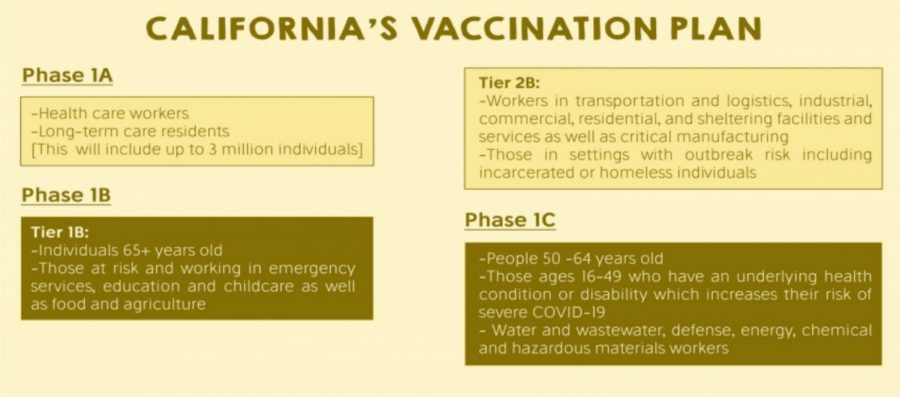California continues to combat virus
Due to Los Angeles County becoming an epicenter of the pandemic and the increasing panic over a more contagious variant of the virus, the county has introduced more specific vaccination plans and imposed stricter guidelines for the public.
Because the federal government allowed each state to organize the manner in which vaccines would be administered, California has struggled to distribute the vaccine in a tiered approach.
According to the LA County Department of Public Health, healthcare workers and members of assisted living facilities are receiving the first doses of the vaccine, followed by people 65 years and older and others at risk of exposure. Then, citizens who are 50 to 64 years old and finally those 16 to 49 years old who have any preexisting health conditions or disabilities will be permitted to receive the next dose of the vaccine. However, whether to vaccinate willing individuals in the 16 to 49 age group who do not have any underlying health conditions is still being debated.
Now that most healthcare workers and members of assisted living facilities are vaccinated, six mass vaccination sites will open starting early February, including new sites located at Fairplex in Pomona, The Forum in Inglewood, Cal State University in Northridge, LA County Office of Education in Downey and Six Flags Magic Mountain in Valencia for people 65 years or older.
However, last week, residents 65 years or older started scheduling vaccination appointments and receiving the vaccine.
“The COVID-19 vaccine rollout has been an enormous undertaking,” said LA County Supervisor Hilda Solis in an emailed statement to CBS LA. “It is critical that we make headway vaccinating people 65 years of age and older as soon as possible—in line with Gov. Gavin Newsom’s recommendations.”
Despite the slight decrease in new daily COVID-19 cases throughout the United States, the discovery of a new strain, B117, has impacted other areas in the world, including LA, as the first B117 case was reported on Jan. 16. This new strain is believed to have first appeared in England during early September and, according to the Centers for Disease Control, is predicted to become the dominant cause of deaths in the U.S. as it is 50 to 70 percent more transmissible than COVID-19.
Meanwhile, President Joe Biden has reinstated bans preventing non-U.S. citizens from entering the nation if they had recently traveled to South Africa, where a new strain of the virus had been discovered.
President Biden also signed an executive order on Jan. 22, his third day in office, ordering for an increase in food assistance for families affected by the pandemic. This order will give low-income families access to federal nutrition and food assistance programs.
Furthermore, the president has urged Congress to pass a $1.9 trillion COVID-19 relief plan which includes additional payments of up to $1,400 to hard-hit Americans.
“We’re in a national emergency,” President Biden said. “We need to act like we’re in a national emergency.”
Your donation will support the student journalists of Diamond Bar High School. Your contribution will allow us to purchase equipment and cover our annual website hosting costs.



